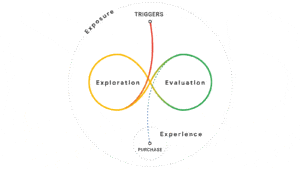How well do you know the “Chaotic” decision journey of your patients?
You have probably wondered what processes bring patients to your clinic and which mechanisms influence their decision to choose you for their initial medical consultation, rather than any other doctor.
When a customer starts the decision-making process for a purchase, he/she doesn’t take a straight line that takes a right to what satisfies the needs but instead enters a loop where many other considerations are at play.
Even plastic surgery patients are not exempt from this mechanism; they go through a confusing and chaotic process before deciding to proceed with the procedure. The erratic search for information that we all perform before making any purchase now has a name: Messy Middle. Google coined the term to describe that what happens between the trigger, and the buying decision isn’t always linear.
“The way people make decisions is messy — and it’s only getting messier. Still, there are a few things we know about purchase behavior. What is less clear however, is how people process all of the information and choices they discover along the way. And what is critical, what we set out to understand with this new research, is how that process influences what people ultimately decide to buy.”
How does behavioural science explain the messy middle?
Cognitive science has proposed two mental models that would underlie the messy middle.

Ph by Think With Google
We know that patients look for information about concerns, procedures, brands, doctors and reviews and then weigh all the options. This mechanism can be summarised in two steps.
- EXPLORATION, an expansive activity
- EVALUATION, a reductive activity
People loop through these twin modes of exploration and evaluation, repeating the cycle as often as they need to make a purchase decision. Any activity a person engages in during his/her patient’s journey can be categorised into one of these two mental modes across a wide range of sources, including search engines, social media, mouth-to-mouth, and review websites.
It is interesting to note that these models existed long before the Internet. What has changed thanks to the digital age is how we search for information, the amount of information we have and the sources we feel are most reliable for us.
How to increase conversions in the middle-funnel?
Conversions attributed to the mid-funnel are 16 TIMES HIGHER using a multi-touch communication strategy. The goal isn’t to force people to exit the loop but to provide reassurance they need to decide. Make sure your brand is visible in all the key phases of your patient’s journey, and ensure your service is at the top of your clients’ minds. Google gives us some interesting tips to optimise the messy middle and improve our conversions in the middle-funnel
- Ensure brand presence, so your product or service is strategically front of mind while your customers explore.
- Close the gap between trigger and purchase, so your existing and potential customers spend less time exposed to competitor brands.
- Build flexible, empowered teams who can work cross-functionally to avoid traditional branding and performance silos that are likely to leave gaps in the messy middle.
Arbrea Labs can give you the resources you need to understand the purchase behaviour of your patients. Thanks to our AR & 3D tools, you can offer them a complete, engaging digital experience to catch their attention and make it much easier for you to stay in touch with them during the evaluation phase.
????Get in touch with us to know how we can support your marketing strategy.
Bibliography
Rennie, Alistair, and Jonny Protheroe. “Navigating Purchase Behavior & Decision-Making – Think with Google.” Think with Google, 14 July 2020







